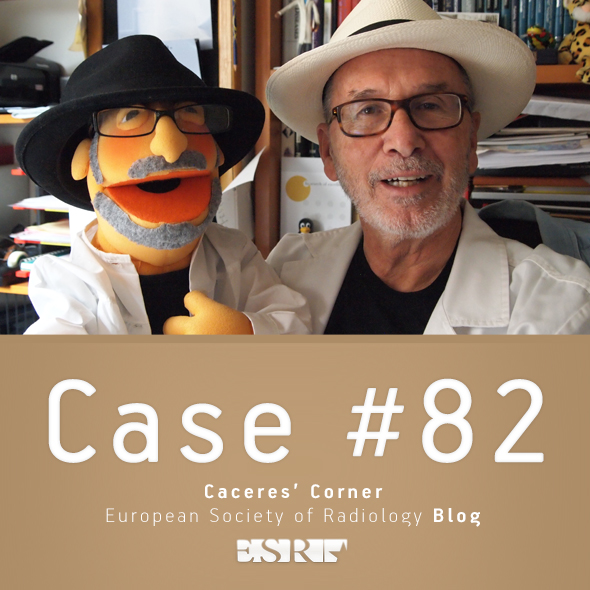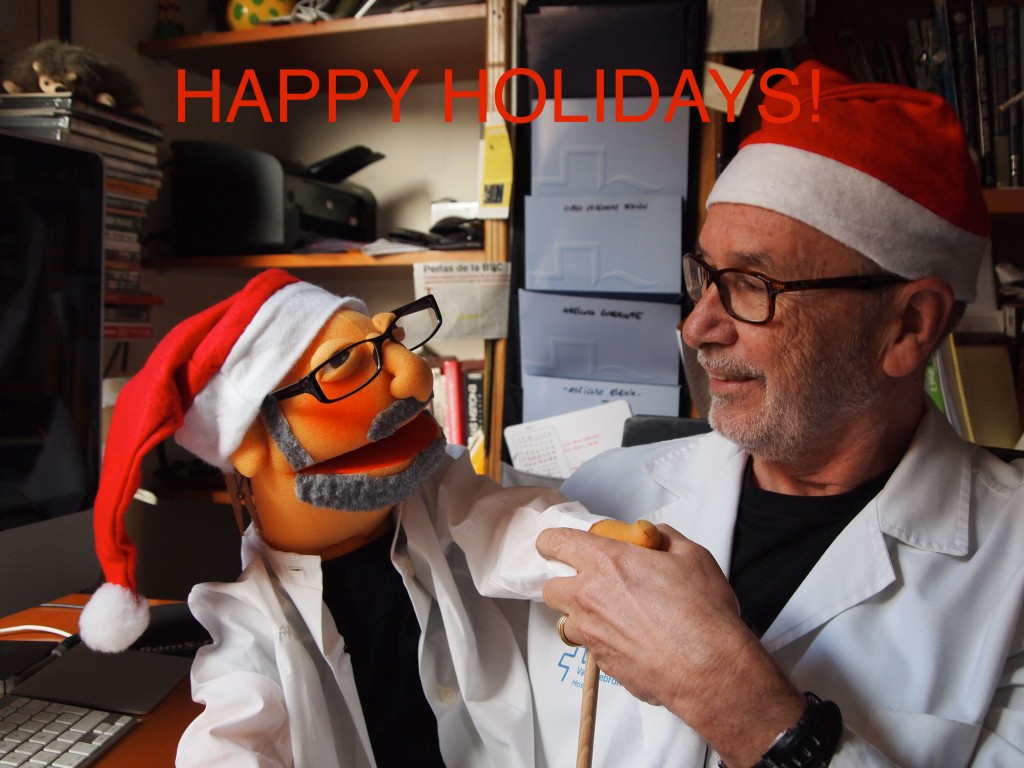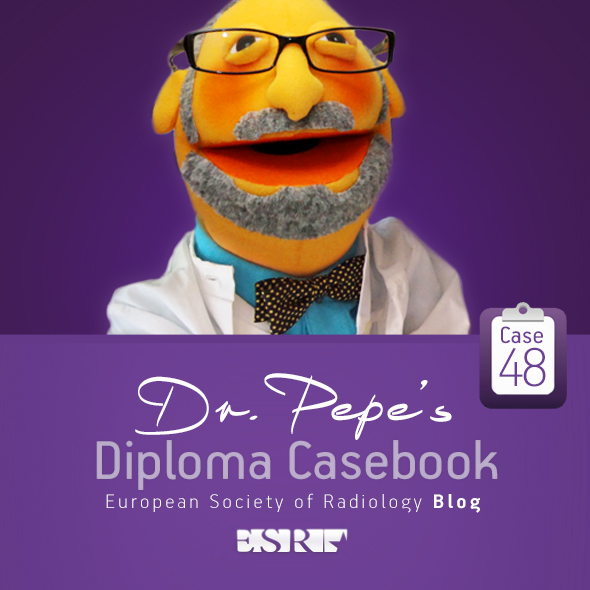
Dear Friends,
Muppet believes that the last week of the year deserves an unusual case. Images belong to a 61 year-old woman with frank haemoptysis for one week.
What would you say about the LLL lesion? Leave your thoughts and diagnosis in the comments section and come back on Friday for the answer.
Read more…

A-254 A. Plain radiography
J. Cáceres | Saturday, March 9, 10:30 – 12:00 / Room A
There are certain signs in the chest radiograph, which help in the identification and differential diagnosis of selected processes. Their appearance is characteristic enough to be identified. Some of them correspond to normal variants, which should not be confused with pathologic processes. In this presentation, we will describe several signs in chest imaging that, in our experience, have proven helpful to us in the diagnosis of chest pathology.

B-0931 Dynamic contrast-enhanced imaging for detection of complications after double-bundle reconstruction of the anterior cruciate ligament
Y.-C. Lin, Y.-H. Juan, Y.-C. Cheung, W.-L. Yeh, C.-H. Chiu, C.-F. Tan, C.-M. Kuo | Monday, March 11, 14:00 – 15:30 / Room E1
Purpose: Double-bundle reconstruction with stump preservation has revolutionized the surgical treatment for anterior cruciate ligament (ACL) injury. However, poor revascularization at the osteoligamentous interface (OI) of the tibia tunnel remains a major cause of graft complications. In this study, we applied dynamic contrast-enhanced (CE) magnetic resonance imaging (MRI) to quantify the OI enhancement values of the tibia tunnels and ACL stump. We aimed to determine the relationship between graft complications and OI and stump enhancements.
Methods and Materials: From October 2011 to April 2012, 34 patients were enrolled in our study (mean postoperative duration, 7.3 months). All patients underwent one 1.5-T MRI study with the imaging pulse-sequence protocol of proton density-weighted imaging (WI), T2WI, pre-enhanced and post-enhanced T1WI, and dynamic CE MRI. Graft complications, including cystic degeneration and tear, were evaluated using pre-enhanced MRI, and peak enhancement (ePeak) values were acquired from a dynamic CE study. The receiver operating characteristic (ROC) analysis was used to obtain optimal cut-off values for complicated grafts.
Results: Our study included 28 patients (mean age, 25.5 years). Nine patients (32.1%) had cystic degeneration and 1 (3.6%) had complete posterolateral (PL) bundle tear. Mean ePeak percentages for graft with or without complications were 84.19%/127.69% for anterior–medial (AM) bundle, 107.54%/128.21% for PL bundle, and 171%/151.06% for stump, respectively. ROC analysis yielded the optimal ePeak cut-off values of 126 %, 104 %, and 35 % for AM bundle, PL bundle, and stump, respectively.
Conclusion: Graft complications were directly associated with higher tibial OI values but inversely associated with higher stump values.

Dear friends,
We will give you some respite this week. We will return on Monday 30, with a very interesting case.
We wish you all very happy holidays!

B-0976 Can a contrast-enhanced ultrasound nephrostogram be used instead of a fluoroscopic nephrostogram: preliminary findings
M. Daneshi, K. Patel, D. Huang, M. Sellars, P. Sidhu | Monday, March 11, 14:00 – 15:30 / Room G/H
Purpose: The use of contrast-enhanced ultrasound (CEUS) has extended beyond traditional uses, and the possibility to delineate percutaneous tubes and drains is achievable. We have compared the traditional fluoroscopic nephrostogram using iodinated contrast agents with CEUS nephrostogram to ascertain the accuracy, utility and convenience of the CEUS nephrostogram.
Methods and Materials: The standard conventional nephrostogram was performed immediately prior to the CEUS nephrostogram. The CEUS nephrostogram technique involved diluting 0.2ml of SonoVue with 40 ml of normal saline and introduced into the renal collecting system via the nephrostomy tube. Digital cine-clips and still images were recorded to allow accurate retrospective comparison by two independent reviewers to the reference standard.
Results: Twelve nephrostomies in 10 patients (median age 64 yrs, range 29-91 yrs, 6 females and 4 males) were performed and reviewed. The renal pelvicalyceal system was visualised in both CEUS and fluoroscopic nephrostograms in 11/12 (92%) with one nephrostomy tube identified as being misplaced. The entire ureter was visualised in 6/12 (50%) with a CEUS nephrostogram compared with 8/12 (75%) using traditional nephrostogram. Fluoroscopic nephrostogram showed drainage of contrast into the bladder in 10/12 (83%) cases compared with 9/12 (75%) using CEUS.
Conclusion: Preliminary results suggest that CEUS nephrostogram is a feasible method to confirm the correct positioning of the nephrostomy tube, image the ureters and determine if there is satisfactory drainage into the bladder. CEUS nephrostogram is a suitable alternative for the traditional nephrostogram in patients with contraindications to iodinated contrast agents or if the procedure needs to be performed at the bedside.

B-0687 Does the adjunct of digital breast tomosynthesis (DBT) increase inter-reader reproducibility of two-dimensional digital mammography (2D-DM)?
G. Di Leo, L.A. Carbonaro, M. Bazzocchi, V. Londero, A. Dal Col, R.M. Trimboli, F. Sardanelli | Sunday, March 10, 10:30 – 12:00 / Room F2
Purpose: To estimate the inter-reader reproducibility of DBT added to 2D-DM in comparison to that of 2D-DM alone.
Methods and Materials: A series of 65 breasts (65 women, aged 58±9 years) underwent DBT (Giotto, IMS, Italy) as an adjunct to 2D-DM. After an agreement on how to report 2D-DM and DBT, 3 independent readers (R1, R2, R3) with >6 years of experience in 2D-DM and >1 year of experience in DBT evaluated all studies. Each reader evaluated the breast density and assigned a BI-RADS score using only 2D-DM. After 30 days, they repeated the evaluation adding DBT to 2D-DM. The inter-reader reproducibility was estimated using the quadratically weighted Cohen’s kappa.
Results: The breast density reported at 2D-DM by the most experienced reader was: 75 % in 1 (1%). Considering the B1, B2, B3, B4, and B5 BI-RADS scores, the same reader assigned the followings: 25, 0, 10, 20, and 10 using 2D-DM; 31, 1, 7, 13, and 13 using 2D-DM plus DBT. For each pair of readers, 2D-DM plus DBT resulted in a higher inter-reader reproducibility than that of 2D-DM alone: kappa value for 2D-DM ranged from 0.418 to 0.566 while that for 2D-DM plus DBT ranged from 0.656 to 0.758.
Conclusion: While the inter-reader reproducibility of 2D-DM resulted only moderate, the adjunction of DBT allowed to reach a substantial reproducibility. The use of DBT added to 2D-DM can reduce inter-reader variability and allow for more reliable readings from different radiologists.

A-149 Chairman’s introduction
V.N. Cassar-Pullicino | Friday, March 8, 16:00 – 17:30 / Room C
In this New Horizon session dedicated to cartilage imaging, the audience will learn of new advances in imaging the normal and abnormal cartilage matrix and understand the basic techniques used in this assessment. It is hoped that these new techniques which are currently in the research field would very soon be translated into clinical application. Early detection of cartilage disease may lead to novel therapies which can help reverse and repair the degenerative process.

Dear Friends,
This week I am presenting images of a 49-year-old woman with abdominal pain and moderate distension. Examine the images below, leave your thoughts in the comments section, and come back on Friday for the answer.
What would be your diagnosis?
1. Hepatomegaly
2. Subpulmonary fluid
3. Diaphragmatic eventration
4. None of the above
Read more…

B-0118 Determination of the vascular input function using magnitude or phase-based MRI: influence on dynamic contrast-enhanced MRI model parameters in carotid plaques
R.H.M. van Hoof, M.T.B. Truijman, E. Hermeling, R.J. van Oostenbrugge, R.J. van der Geest, M.J.A.P. Daemen, J.E. Wildberger, W.H. Backes, M.E. Kooi | Thursday, March 7, 10:30 – 12:00 / Room N/O
Purpose: A reliable vascular input function (VIF) is important for quantitative analysis of atherosclerotic carotid plaque microvasculature using dynamic contrast-enhanced (DCE) MRI. In tumour imaging and brain perfusion studies, it has been demonstrated that a phase-based VIF (ph-VIF) is less sensitive to flow artefacts compared to magnitude-based VIF (m-VIF). The purpose is (1) to compare m-VIF and ph-VIF and (2) to investigate the influence of different VIFs on DCE MRI model parameters in carotid plaques.
Methods and Materials: 21 patients with 30-99% carotid stenosis underwent 3 T DCE MRI. Data from four patients, scanned with a high temporal resolution were used to construct group-averaged m-VIF and ph-VIF of the jugular vein. The other 17 patients were used for calculating Ktrans (measure of plaque microvasculature) using m-VIF and ph-VIF. The effect of neglecting flow on the m-VIF was estimated using the Bloch equations.
Results: Peak concentrations of m-VIFs were on average 4-fold lower than for ph-VIFs (p<0.001). Despite these differences, strong and significant correlation between Ktrans determined using group averaged m-VIF and ph-VIF was found (Pearson’s correlation 0.91, p<0.001). Taking into account a theoretical flow of 8 cm/sec, the discrepancy in peak concentration of m-VIF and ph-VIF disappeared.
Conclusion: Our data suggest a strong influence of flow when calculating m-VIF of the jugular vein. Despite this, strong correlation between Ktransparameters determined using m-VIF and ph-VIF was found. It is expected that a phase-based VIF results in a quantitative more realistic value of Ktrans.

A-285 The Spanish radiographer’s role in advanced MRI research
E. Alfayate Sáez | Saturday, March 9, 14:00 – 15:30 / Room B
A Radiographer, as part of a MRI research team, is more than just a professional obtaining patient´s images for either the investigational studies or clinical trials. Being part of the team means participating and understanding the project as a whole. It means one must know the study’s objectives, collaborate in the protocol design and optimization, and inform the patient about the exam and steps to follow in order to maximize his cooperation. Personal data protection and individual privacy must be guaranteed through all the process; a written informed consent should be signed by the patient as well. Taking care of all these particular aspects is very important for a successful completion of each study/trial. Due to rapid technological advances, and the necessity to deal permanently with state-of-the-art scientific areas, Continuous Professional Development (CPD) for a Radiographer working in a research team is critical. The radiographer is part of a multidisciplinary team, where each professional performs a very specialized task, combining efforts is crucial in order to produce a work of excellence that can be shared with the scientific community. Thanks to the continuous investment in new technology, we have the opportunity, in our site, to conduct research in diverse areas, such as cardiology, traumatology, gynaecology, obstetrics and neurology. Through this presentation we will share some of the research we are working on, as well as the importance of the Radiographer role in a research centre.









